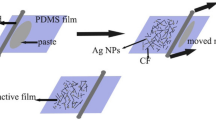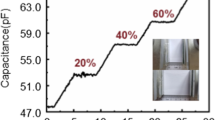Abstract
Recently, several sensors using conductive nanoparticles on flexible substrates have been developed for various healthcare wearable device applications. These sensors primarily use a change in electrical resistance or a change in electrical capacitance owing to deformation of the sensor structure (e.g., membrane) because of the external motion or force. In the flexible sensor development process, the change in the reference resistance, as well as the change owing to the deformation of the sensor during the measurement process, should be small. In this study, we introduced an electrode connection method using a contact probe that can reduce the resistance change owing to the deformation of the flexible membrane sensor and compared the change in reference resistance with the conventional large-area contact connection method. For the probe type, it was confirmed that the change in the reference resistance was reduced during the repeated process of attaching and detaching the sensor. The rate of change in the reference resistance before and after deformation by static vertical force was also reduced compared to the area type, and it was confirmed that it was maintained constant. Finally, the rate of change in the reference resistance of the probe type was confirmed to be reduced compared to the case of the area type owing to repeated impact force by a free-falling metal bead.
Similar content being viewed by others
Abbreviations
- AgNW :
-
Silver nanowire
- F v :
-
Applied vertical force
- R ref_before :
-
Reference resistance before deformation
- R ref_after :
-
Reference resistance after deformation
- Δ R ref :
-
Change in reference resistance
- Δ R ref/R ref_before :
-
Change rate of reference resistance
- R 0 :
-
Initial resistance of senor
- Δ R/R 0 :
-
Relative resistance change
References
C. Pang, C. Lee and K. Suh, Recent advances in flexible sensors for wearable and implantable devices, J. Appl. Polym. Sci., 130(3) (2013) 1429–1441.
S. Duan, Z. Wang, L. Zhang, J. Liu and C. Li, A highly stretchable, sensitive, and transparent strain sensor based on binary hybrid network consisting of hierarchical multiscale metal nanowires, Adv. Mater. Technol., 3(6) (2018) 1800020.
S. Shengbo, L. Lihua, J. Aoqun, D. Qianqian, J. Jianlong, Z. Qiang and Z. Wendong, Highly sensitive wearable strain sensor based on silver nanowires and nanoparticles, Nanotechnology, 29(25) (2018) 255202.
M. Zhao, D. Li, J. Huang, D. Wang, A. Mensah and Q. Wei, A multifunctional and highly stretchable electronic device based on silver nanowire/wrap yarn composite for a wearable strain sensor and heater, J. Mater. Chem. C., 7 (2019) 13468–13476.
T. Li, J. Li, A. Zhong, F. Han, R. Sun, C. Wong, F. Niu, G. Zhang and Y. Jin, A flexible strain sensor based on CNTs/PDMS microspheres for human motion detection, Sens. Actuators A, 306 (2020) 111959.
S. Ryu, P. Lee, J. B. Chou, R. Xu, R. Zhao, A. J. Hart and S. Kim, Extremely elastic wearable carbon nanotube fiber strain sensor for monitoring of human motion, ACS Nano, 9(6) (2015) 5929–5936.
I. Kang and K. Kim, Nano-carbon strain sensors for the development of the sensing devices of the fourth industrial revolution, Trans. Korean Soc. Mech. Eng. A, 42(2) (2018) 185–194.
S. Y. Kim and I. Kang, A study on the development of a novel pressure sensor based on nano carbon piezoresistive composite by using 3D printing, Trans. Korean Soc. Mech. Eng. A, 41(3) (2017) 187–192.
H. Yun, H. Kim and I. Lee, Research for improved flexible tactile sensor sensitivity, Journal of Mechanical Science and Technology, 29(12) (2015) 5133–5138.
C. Fekiri, S. H. Kim, H. Kim and I. Lee, Improved resistance stability for tactile sensor fabrication and investigation of the dispensing parameters of a nanocomposite material, Journal of Mechanical Science and Technology, 33(12) (2019) 5631–5636.
T. Yang, X. Jiang, Y. Zhong, X. Zhao, S. Lin, J. Li, X. Li, J. Xu, Z. Li and H. Zhu, A wearable and highly sensitive graphene strain sensor for precise home-based pulse wave monitoring, ACS Sens, 2(7) (2017) 967–974.
M. Amjadi, K. Kyung, I. Park and M. Sitti, Stretchable, Skin-mountable, and wearable strain sensors and their potential applications: a review, Adv. Funct. Mater., 26(11) (2016) 1678–1698.
S. Zhang, H. Zhang, G. Yao, F. Liao, M. Gao, Z. Huang, K. Li and Y. Lin, Highly stretchable, sensitive, and flexible strain sensors based on silver nanoparticles/carbon nanotubes composites, J. Alloys Compd., 652 (2015) 48–54.
C. Li, L. Pan, C. Deng, P. Wang, Y. Huang and H. Nasir, A flexible, ultra-sensitive strain sensor based on carbon nanocoil network fabricated by an electrophoretic method, Nanoscale, 9(28) (2017) 9872–9878.
M. Amjadi, A. Pichitpajongkit, S. Lee, S. Ryu and I. Park, Highly stretchable and sensitive strain sensor based on silver nanowire-elastomer nanocomposite, ACS Nano, 8(5) (2014) 5154–5163.
S. Chun, Y. Choi and W. Park, All-graphene strain sensor on soft substrate, Carbon, 116 (2017) 753–759.
K. K. Kim, S. Hong, H. M. Cho, J. Lee, Y. D. Suh, J. Ham and S. H. Ko, Highly sensitive and stretchable multidimensional strain sensor with prestrained anisotropic metal nanowire percolation networks, Nano Letters, 15(8) (2015) 5240–5247.
Acknowledgments
This work was supported by a National Research Foundation of Korea (NRF) grant funded by the Korean government (MSIT) (No. NRF-2020R1F1A1050735) and Korea Basic Science Institute (National research Facilities and Equipment Center) grant funded by the Ministry of Education (No. 2019R1A6C1010045).
Author information
Authors and Affiliations
Corresponding author
Additional information
Dong Kwan Kang is B.S. candidate in Division of Mechanical, Automotive, Robot Components Engineering, in Dong-Eui University. His research interest in MEMS and flexible sensors.
Sangmin Lee is Assistant Professor in Division of Mechanical, Automotive, Robot Components Engineering, Dong-Eui University. His research interest is MEMS and microfluidic system. He received his B.S. (2005) in Mechanical Engineering from Pusan National University and Ph.D. (2012) in Mechanical Engineering from Postech.
Rights and permissions
About this article
Cite this article
Kang, D.K., Lee, S. Electrode connection to reduce the variation of electrical resistance owing to deformation of a flexible sensor. J Mech Sci Technol 36, 3097–3101 (2022). https://doi.org/10.1007/s12206-022-0540-9
Received:
Revised:
Accepted:
Published:
Issue Date:
DOI: https://doi.org/10.1007/s12206-022-0540-9




